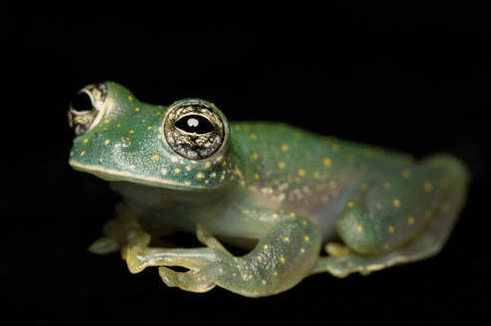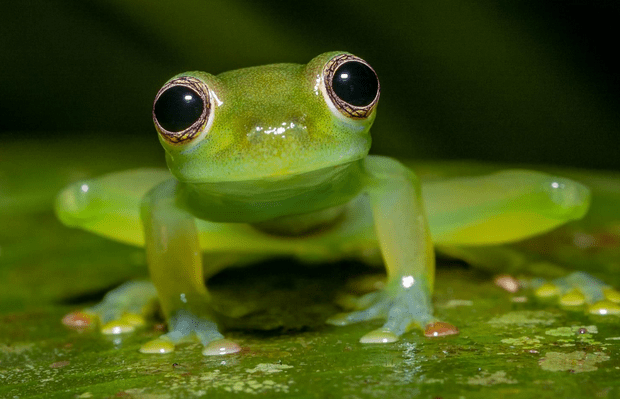The glass frog is one of the most unique and fascinating creatures in the world. With their oddly colored translucent skin, this frog may wow you at the first sight. There is more to these frogs than just their appearance, they have many interesting traits that make them uniquely adapted to their environment. Here are 8 interesting facts about the glass frog.
Phylum: Chordata
Class: Amphibia
Order: Anura
Family: Centrolenidae
1. You can see through a glass frog
Glass frogs are members of the Centrolenidae family. They have specific characteristics that make them impossible to be mistaken for other species in the wild. They have a fascinating and gorgeous appearance that is almost mystical.
When you look at a glass frog from above, it looks no different from any other tree frog. However, the most distinguishing feature of this species is the translucent skin on its belly. You can see all of its inner organs, like intestines, bones, heart, and other organs from below.
This feature makes the frog look fragile. But, in contrast to your thought, its translucent belly makes it safer. Because of this characteristic, this species can repose its legs close to the body and softens the borders, making the frog’s shape less visible. This helps the frog camouflage and makes it less obvious to birds of prey.
There are about 160 glass frog species and most of them process bright green or lime hue. There are still some species that come with brown skin like the Nymphargus rosada or blue skin like the Ecuadorian blue glass frog (Cochranella mache). Some species will have colored dots (black, white, etc) on their green body. Their organ can also be varied hues depending on the species.

See-through frogs are generally small, although there are size differences between species. They have an average size of 1 – 3 in (3-7.5 cm) in length. They are also quite light. With this size, they can fit in your hand.
The glass frog is one of the weirdest amphibians in the world, you may find more related articles below:
2. They Are Found Only in America
Glass frogs are only found in South and Central America, like Honduras, Belize, Panama, Mexico, Ecuador, Costa Rica, Guatemala, and Colombia. They live in wet montane rainforests and tropical lowland to (semi elevation) mountain forests

They also inhabit Bolivia, Venezuela’s Andes, and Trinidad and Tobago. Some species locate around Amazon and Orinoco rivers, northern Argentina, the Guiana Shield, and southeastern Brazil.
These frogs are arboreal species that prefer to live near bodies of water. As a result, most of them will be found beneath the leaves of trees or shrubs near forest streams.
3. Types of glass frogs
These see-through frogs are divided into about 160 species and 12 genera. Most of them are in 3 genera: Hyalinobatrachium, Cochranella, and Centrolene. Here are some types of them:
– Reticulated glass frog (Hyalinobatrachium valerioi): This frog is also known as the la palma glass frog. It has yellow dots on its back and golden eyes. Small black stains in the green parts are possible. It has a white liver and digestive tract, and its heart is covered with white tissue.

– Fleischmann’s glass frog (Hyalinobatrachium fleischmanni) is also called the northern glass frog. This species comes in green color with yellowish markings and a partly translucent white belly. It has yellow fingertips and golden eyes with a horizontally oval pupil. This frog looks like the Yellow-flecked Glassfrog and the Powdered Glassfrog.
– Chiriqui or Powdered glass frog (Teratohyla pulverata) stands out from other frogs with its noticeable appearance. It has lime-green skin with white, unevenly-sized dots. It looks like the frog is sprinkled with talcum powder. That’s why it got the name.

– Bare-hearted glass frog(Hyalinobatrachium colymbiphyllum), aka plantation or cricket glass frog: is green with yellow dots. This frog has the clearest belly in the family, so you can see almost every inner organ in its body.
– Diane’s bare-hearted glass frog (Hyalinobatrachium dianae) is also called a Kermit frog because of its unusual look. Its skin has a grainy texture and a consistent tint with no visible light or dark difference. Its irises are silvery-white with tiny dark dots.

Some other species are the ghost or limon giant glass frog (Sachatamia ilex), the sun or atrato glass frog (Hyalinobatrachium aureoguttatum), the Nicaragua giant or emerald glass frog (Centrolene prosoblepon), the yuruani glass frog (Hyalinobatrachium iaspidiense), the Hyalinobatrachium mashpi, the pacific giant glass frog (Centrolene Geckoideum), the granular glass frog (Cochranella granulosa) aka gainy Cochran frog, etc.
4. They can swim pretty well
Glass frogs are tree frog species, that’s why they spend most of their time in trees. They only come down in the breeding season to find partners and reproduce. This keeps them safe from predators on the ground.
Although these frogs are arboreal creatures, they can swim quite quickly in small rivers and woodland streams. Their tadpoles have robust bodies that allow them to swim across rocky streams.
These amphibians are active at night (nocturnal). They forage for food from night until dawn. When the sun rises, they seek refuge in the top canopy of the trees, where they can hide and rest.

When threatened by predators, these frogs will employ their climbing abilities to move deeper into the protection of dense forests. If it doesn’t work, they will leap. Compared to the small size, they can jump quite high and over a long distance, more than 10 feet in just one jump.
These frogs typically dwell in tiny groups which are called armies. During mating season, males are extremely territorial. They designate their own territories with distinct calls.
5. Diet
See-through frogs are carnivorous, though they don’t have teeth and their tongue is short. Their diet is primarily comprised of little insects, such as moths, ants, spiders, flies, crickets, and tiny bugs crawling over the tree branches. When there’s a change, they will even eat other frogs that are smaller than them.
Their hunting strategy is to ambush the prey. This means they will remain motionless and wait for the prey to crawl up within their reach. They then flip their tongue out to catch and eat the prey.

Their exceptional vision allows them to capture and eat insects more easily. Their large and bulbous eyes can rotate independently.
Their tadpoles are omnivorous. They consume everything, from moss, and algae to mosquito larvae and other tiny insects.
6. Predators
In the rainforests where they live, adult transparent frogs face many predators. They can be eaten by snakes or prey of birds while in the trees. In the mating season, they can be preyed on by lizards and other small mammals when getting to the ground.

Tadpoles in the water are great meals for beetles, fish, dragonfly larvae, and even birds.
Wasps and frog flies are the main predators of see-through frog eggs. The wasps will eat the frog eggs, while the flies will deposit their eggs on the glass frog’s eggs. After the eggs of the flies hatch, they will consume the frog embryos.
7. They are dedicated fathers
When the first rain falls in the forests, it’s a sign of glass frogs’ breeding season. Males go down from their lofty position and move closer to the stream. They will find a good place which is usually a large leaf just above a running stream, to mate and have their offspring.
If they find it, they do everything they can to perch on it; even if they have to fight with other males. The winner will take it all. After perching on the leaf, the males will make high-pitched sounds to woo females. If the female is attracted, she will come to the male and they begin to mate.
The male climbs her back and calmly waits for her to lay a clutch of up to 30 eggs on or under the leaf (depending on the species). Interestingly, you can see the eggs inside the body of the female before she lays them.
These eggs are coated with a clear material that resembles liquid glue to keep them securely attached to the leaf. They are then fertilized by the male. The female returns to the trees, leaving her partner behind with their eggs. The territorial male will be in charge of watching over the eggs continuously until they hatch (about 2 weeks).
They frequently have to combat predators such as carnivorous wasps. When a wasp tries to take an egg, the frog farther will kick the wasp away, making it fly into the forest. Other frog species do not have parental care like that.
In some species, the males whistle again to attract new females to breed and lay a new clutch of eggs. A male can protect numerous clutches of eggs as long as they fit on the laying leaf.
When the tadpole embryos reach a certain size, they break out from the eggs and fall into the stream below. The tadpoles live at the stream’s bottom for 10 months before transforming into adults.
Those that make it to adulthood find their way out of the stream. They climb the trees to join the other glass frogs. The average lifespan of these frogs is pretty long for such a small species. They can live for about 10-14 years if they’re not preyed on and eaten by predators.

8. They Are Threatened
Although these frogs are killed by many animals in the wild, their most serious threat is habitat loss due to deforestation.
Rainforests in Central and South America are cut down for agricultural activities. According to a survey, in 2021, about 186,000 hectares of natural forest were destroyed in Mexico. The amphibians lose their place to live and they are unable to develop the essential modifications to withstand this human invasion.

Furthermore, human poachers attempt to capture them in protected regions in order to sell them to collectors.
Sadly, about two-thirds of the species are declining, and only one-third are stable. There are up to 36 glass frog species that are threatened, at every different level. They are all protected in their native countries
References:
- https://www.treehugger.com/glass-frog-facts-6823469
- https://a-z-animals.com/animals/glass-frog/
- https://www.semanticscholar.org/paper/

